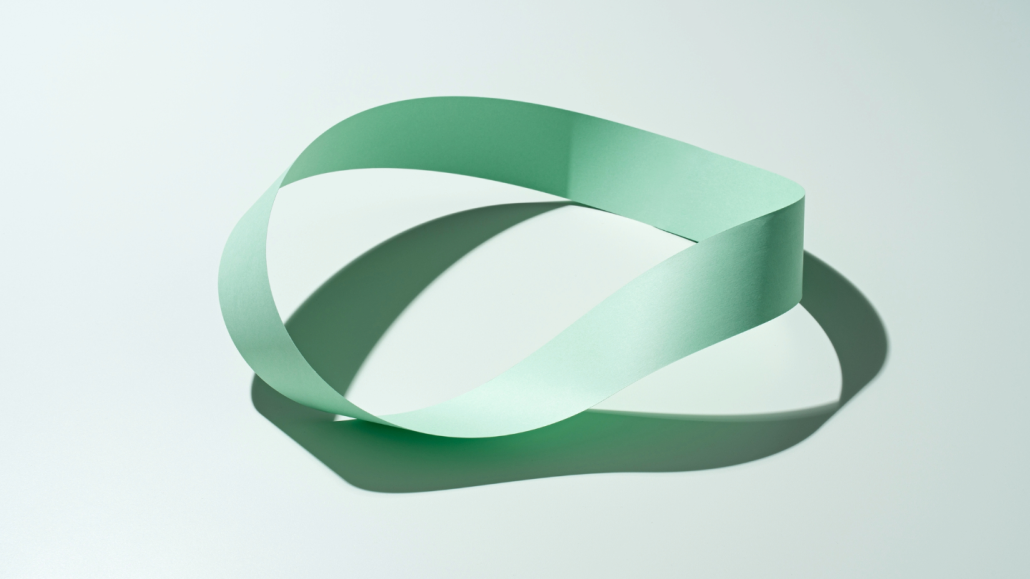An enduring Möbius strip mystery has finally been solved
A mathematician’s journey to prove how short the loops can be had some twists and turns

A Möbius strip (one shown) is a loop of paper with a half-twist in it. A mathematician has now proven the shortest possible Möbius strip for a given width.
MirageC/Moment/Getty Images Plus
- More than 2 years ago
Read another version of this article at Science News Explores
Any attempt to better understand Möbius strips is bound to run into some kinks.
The twisted loops are so strange that mathematicians have struggled to answer some basic questions about them. For example: “What’s the shortest Möbius strip you can make for a paper band of a given width?”
The question hooked mathematician Richard Evan Schwartz. A mistake in a computer program almost prevented him from finding the answer. Simply messing around with strips of paper finally helped him solve the mystery.
A Möbius strip is a mathematical oddity that anyone can make. Cut a strip of paper, twist one end halfway around, and tape the two ends together to form a loop with a twist in it. The result is a one-sided surface. The strips have inspired mathematicians, artists and scientists in a variety of fields (SN: 5/27/22).
A long, skinny Möbius strip is easier to make than a stumpy one. With a very short strip, the paper has to contort so much that it flattens into an equilateral triangle (SN: 7/24/07). (You can see this shape form if you slowly pull one end of an untaped Möbius strip to shorten it.) The triangular Möbius strip is made from a piece of paper that has a length that’s √3, or about 1.73, times its width.
In 1977, mathematicians hypothesized that the triangular Möbius strip was as short as you can go. Specifically, it’s the limit for an idealized mathematical version of paper that is infinitely thin, smooth and nonstretchy, and which, like real-world paper, can’t pass through itself. But in the nearly 50 years that followed, no one had been able to prove it. Mathematicians could show only that the ratio between a Möbius strip’s length and width must be greater than π/2, or about 1.57.
The stumper piqued Schwartz’s interest. He is fond of simple problems that befuddle mathematicians. “I like it when no one has any idea what to do,” he says. A bonus: “If I bomb out on this, there’s no shame in it. I’m just like everybody else.”
Schwartz focused on a key property of Möbius strips: While the paper curves this way and that to form the loop, at every point on the band there’s a direction in which the paper follows a straight line from edge to edge, with no curvature at all. (That’s not true of all surfaces. Think of a bowl: There are no straight lines to be found.) He realized that, in any Möbius strip, there must always be two such lines that are perpendicular and in the same plane, as in the letter T.
Based on how the paper contorts to form this T shape, Schwartz found a new minimum length-to-width ratio. To his disappointment, it was not √3 but a number achingly close to it, about 1.69, he reported in Geometriae Dedicata in 2021.

Schwartz moved on to other topics but couldn’t stop thinking about the problem. One day, on a whim, he began playing with strips of paper. In a head-smacking jolt, he realized he’d made an error.
Schwartz had assumed that slicing open a Möbius strip along a diagonal and flattening it forms a parallelogram. But when Schwartz cut open one of his paper Möbius strips, he saw in front of him not a parallelogram, but a trapezoid. “I instantly said, ‘uh oh,’” he says.
It was a simple mistake. But Schwartz had been investigating Möbius strips primarily on the computer. He’d flubbed the setup of his computer program, which led to the parallelogram whoopsie. “Once I’d made the mistake,” he says, “it’s like it got locked into my brain.”
Schwartz says he hardly ever used paper Möbius strips in his research. But that’s what it took to jolt him out of his stagnant thought pattern. It’s a bit curious that Schwartz didn’t turn to paper earlier. He fiddles with paper as a hobby, designing elaborate masks of dangling paper.
Once Schwartz redid the calculation with the trapezoid fix, √3 popped out. He’d finally proved, that the length of a Möbius strip must be greater than √3 times its width, Schwartz reported August 24 at arXiv.org. The triangular Möbius strip is truly the limit for paper Möbius strips.
Now, Schwartz is interested in taking this work further. What, he wonders, is the minimum length for a loop with two twists, or three twists, instead of one? This time, perhaps, he’ll spend more time playing with paper.






